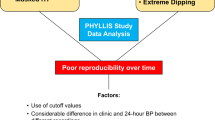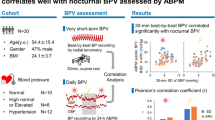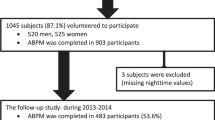Abstract
A number of studies have shown that a smaller than normal nocturnal blood pressure (BP) decrease is associated with cardiovascular disease. However, no large prospective studies have examined the reliability of nocturnal dipping within individuals. The aim of our study was to investigate the short-term variability of nocturnal BP fall in a large cohort of patients with recently diagnosed essential hypertension. In all, 414 uncomplicated never treated hypertensive patients referred to our outpatient hypertension hospital clinic (mean age 46±12 years; 257 M, 157 F) prospectively underwent: (1) repeated clinic BP measurements; (2) routine examinations recommended by WHO/ISH guidelines; and (3) ambulatory BP monitoring (ABPM) twice within a 4-week period. Dipping pattern was defined as a reduction in the average systolic and diastolic BP at night greater than 10% compared to average daytime values. Overall, 311 patients (75.1%) showed no change in their diurnal variations in BP. Of the 278 patients who had a dipping pattern on the first ABPM, 219 (78.7%) confirmed this type of profile on the second ABPM, while 59 (21.3%) showed a nondipping pattern. Among 37 dipper patients with >20% of nocturnal systolic BP decrease (extreme dippers), only 16 (43.2%) had this marked fall in BP on the second ABPM. Of the 136 patients who had a nondipping pattern on the first ABPM, 92 (67.6%) confirmed their initial profile on the second ABPM, while 44 (32.4%) did not. Patients with reproducible nondipping profile were older (48±12 years) than those with reproducible dipping profile (44±12 years, P<0.05). These findings indicate that: (1) short-term reproducibility of nocturnal fall in BP in untreated middle-aged hypertensives is rather limited: overall, one-fourth of patients changed their initial dipping patterns when they were studied again after a few weeks; (2) this was particularly true for extreme dipping and nondipping patterns; (3) abnormalities in nocturnal BP fall, assessed by a single ABPM, cannot be taken as independent predictors of increased cardiovascular risk.
This is a preview of subscription content, access via your institution
Access options
Subscribe to this journal
Receive 12 digital issues and online access to articles
$119.00 per year
only $9.92 per issue
Buy this article
- Purchase on Springer Link
- Instant access to full article PDF
Prices may be subject to local taxes which are calculated during checkout


Similar content being viewed by others
References
Palatini P . Too much of a good thing? A critique of overemphasis on the use of ambulatory blood pressure monitoring in clinical practice. J Hypertens 2002; 20: 1917–1923.
Mancia G et al. Ambulatory blood pressure monitoring. J Hypertens 1996; 14 (Suppl 2): S61–S66.
Zanchetti A . The role of ambulatory blood pressure monitoring in clinical practice. Am J Hypertens 1997; 10: 1069–1080.
Mancia G, Parati G . Ambulatory blood pressure and organ damage. Hypertension 2000; 36: 894–900.
Fagard R, Staessen J, Thijs L . Prediction of cardiac structure and function by repeated clinic and ambulatory blood pressure. Hypertension 1997; 29: 22–29.
Verdecchia P . Prognostic value of ambulatory blood pressure. Current evidence and clinical implications. Hypertension 2000; 35: 844–851.
Verdecchia P et al. Ambulatory blood pressure an independent predictor of prognosis in essential hypertension. Hypertension 1994; 24: 793–801.
Kikuya M et al. Prognostic significance of blood pressure and heart rate variability. Hypertension 2000; 36: 901–906.
Sander D et al. Relationship between circadian blood pressure patterns and progression of early carotid atherosclerosis: a 3-year follow-up study. Circulation 2000; 26: 1536–1541.
Parati G, Lantelme P . Blood pressure variability, target organ damage and cardiovascular events. J Hypertens 2002; 20: 1725–1729.
Frattola A et al. Prognostic value of 24-hour BP variability. J Hypertens 1993; 11: 1133–1137.
Pickering TG . The clinical significance of diurnal blood pressure variations. Dippers and nondippers. Circulation 1990; 81: 700–702.
Staessen JA et al. The diurnal blood pressure profile: a population study. Am J Hypertens 1992; 5: 386–392.
Verdecchia P, Schillaci G, Porcellati G . Dippers versus nondippers. J Hypertens 1991; 9 (Suppl 2): S42–S44.
Staessen JA et al. Nocturnal blood pressure fall on ambulatory monitoring in a large international database. Hypertension 1997; 29: 30–39.
Parati G . Blood pressure reduction at night: sleep and beyond. J Hypertens 2000; 18: 1725–1729.
Verdecchia P et al. Circadian BP changes and left ventricular hypertrophy in essential hypertension. Circulation 1990; 81: 528–536.
Pierdomenico SD et al. Arterial disease in dipper and nondipper hypertensive patients. Am J Hypertens 1997; 10: 511–518.
Bianchi S et al. Diurnal variations of blood pressure and microalbuminuria in essential hypertension. Am J Hypertens 1994; 7: 23–29.
Roman MJ et al. Is the absence of a nocturnal fall in blood pressure (nondipping) associated with cardiovascular target organ damage? J Hypertens 1997; 15: 969–978.
Grandi AM et al. Relation of extent of nocturnal blood pressure decrease to cardiovascular remodelling in never-treated patients with essential hypertension. Am J Cardiol 2002; 89: 1193–1196.
O'Brien E, Mee F, Atkins N, O'Malley K . Accuracy of the SpaceLabs 90207 determined by the British Hypertension Society protocol. J Hypertens 1991; 9: 573–574.
Cuspidi C et al. Short-term reproducibility of nocturnal nondipping pattern in recently diagnosed essential hypertensives. Blood Press 2002; 11: 79–83.
Kario K et al. Nocturnal fall of blood pressure and silent cerebrovascular damage in elderly hypertensive patients: advanced silent cerebrovascular damage in extreme-dippers. Hypertension 1996; 27: 130–135.
Kario K, Pickering TG . Does an extreme-dipping status of nocturnal blood pressure in the elderly hypertensive confer high risk of developing ischemic target organ damage from antihypertensive therapy? Arch Intern Med 2000; 160: 1378.
Hoshide Y et al. Incomplete benefit of antihypertensive therapy on stroke reduction in older hypertensives with abnormal nocturnal blood pressure dipping (extreme-dippers and reverse-dippers). Am J Hypertens 2002; 15: 844–850.
Dimsdale JE, Heeren MM . How reliable is nighttime blood pressure dipping? Am J Hypertens 1998; 11: 606–609.
James MA, Fotherby, Potter JF . Reproducibility of the circadian systolic blood pressure variation in the elderly. J Hypertens 1995; 13: 1097–1103.
Mochizuchi Y et al. Limited reproducibility of circadian variation in blood pressure dippers and nondippers. Am J Hypertens 1998; 11: 403–409.
Omboni S et al. Reproducibility and clinical value of nocturnal hypotension, prospective evidence from the SAMPLE Study. J Hypertens 1998; 16: 733–738.
Manning G, Rushton L, Donnelly R, Millar-Craig MW . Variability of diurnal changes in ambulatory blood pressure and nocturnal dipping status in untreated hypertensive and normotensive subjects. Am J Hypertens 2000; 13: 1035–1038.
Dimsdale I et al. Reliability of nocturnal blood pressure dipping. Blood Press Monit 2000; 5: 217–221.
Cuspidi C et al. Reduced nocturnal fall in blood pressure, assessed by two ambulatory blood pressure monitorings and cardiac alterations in early phases of untreated essential hypertension. J Hum Hypertens 2003; 17: 245–251.
Author information
Authors and Affiliations
Corresponding author
Rights and permissions
About this article
Cite this article
Cuspidi, C., Meani, S., Salerno, M. et al. Reproducibility of nocturnal blood pressure fall in early phases of untreated essential hypertension: a prospective observational study. J Hum Hypertens 18, 503–509 (2004). https://doi.org/10.1038/sj.jhh.1001681
Received:
Accepted:
Published:
Issue Date:
DOI: https://doi.org/10.1038/sj.jhh.1001681
Keywords
This article is cited by
-
Blood pressure and its variability: classic and novel measurement techniques
Nature Reviews Cardiology (2022)
-
Increasing ambulatory pulse pressure predicts the development of left ventricular hypertrophy during long-term follow-up
Journal of Human Hypertension (2018)
-
Association of nocturnal blood pressure patterns with inflammation and central and peripheral estimates of vascular health in rheumatoid arthritis
Journal of Human Hypertension (2018)
-
Effect of telmisartan vs. ramipril on ‘dipping’ status and blood pressure variability: pooled analysis of the PRISMA studies
Hypertension Research (2014)
-
Ambulante 24-h-Langzeitblutdruckmessung
CME (2014)



